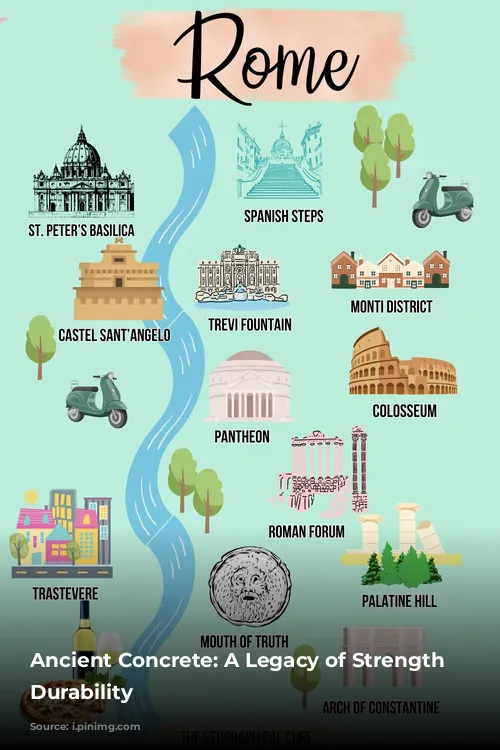Imagine standing before the majestic Colosseum in Rome, a structure that has withstood the test of time for almost 2,000 years. This incredible feat of engineering is a testament to the strength and durability of ancient concrete, a material that continues to fascinate scientists and engineers today.
Let’s delve into the history of concrete, starting with its humble beginnings. The ancient Egyptians, masters of construction, used a simple yet effective mixture of mud, straw, and gypsum to build their iconic pyramids. While impressive for their time, this early form of concrete lacked the strength and resilience of later developments.
The Rise of Roman Concrete
The Romans, renowned for their architectural prowess, revolutionized concrete construction. They discovered the power of a volcanic rock called “pozzolana,” found near the city of Pozzuoli in Italy. This unique material, when combined with lime and local aggregates, formed a concrete that was far superior to its predecessors.
This ingenious blend possessed incredible durability, allowing the Romans to construct iconic structures like the Colosseum, which stands tall even after centuries of weathering.
The Secret to Ancient Concrete’s Strength: Quicklime
What made Roman concrete so exceptional? The answer lies in a key ingredient: quicklime. This reactive material, when mixed with seawater, generated heat and a high pH environment. This crucial step triggered a chemical reaction with the alumina and silicates present in the volcanic ash and other calcium-rich minerals.
This reaction created a strong mortar, which was then combined with volcanic rock and sand to form the robust Roman concrete. The process was akin to baking a cake, where the heat and chemical interactions created a solid, durable structure.
The Science Behind the Strength
The magic of Roman concrete lies in the intricate chemical reactions that occur when quicklime and pozzolana meet water. The calcium oxide in quicklime reacts with water to form calcium hydroxide. This compound then interacts with the silica and alumina in the pozzolana, leading to the formation of calcium silicate hydrates (C-S-H) and calcium aluminate hydrates (C-A-H).
These compounds act as the primary binding agents in cement, giving ancient concrete its strength. This process, known as the pozzolanic reaction, also generates significant heat and releases hydrogen gas.
The C-S-H and C-A-H bind together to create a robust, durable material that hardens over time. This intricate dance of chemical reactions and the interplay of materials gave ancient concrete its remarkable resilience.
A Self-Healing Wonder
One of the most remarkable aspects of ancient concrete is its ability to self-heal. Unlike modern concrete, which is prone to cracking and deterioration, ancient concrete could actually repair itself over time.
This remarkable property was due to the unique chemistry of the pozzolana and quicklime mixture. As seawater seeped into the concrete, it reacted with the exposed volcanic ash and lime, forming new calcium-aluminum-silicate-hydrate minerals within the cracks and voids.
This process, known as remineralization, strengthened the concrete, making it even more durable over time.
The Rise of Portland Cement
While ancient concrete was a marvel of engineering, it had its limitations. The use of volcanic ash, which was often transported from specific locations, made it a less accessible material.
The invention of Portland cement, a mixture of limestone, clay, and other materials, revolutionized concrete production. Portland cement could be made from readily available materials, making it more affordable and accessible.
However, Portland cement-based concrete, while strong and durable, lacks the long-lasting qualities of ancient concrete. It is more susceptible to chemical and physical degradation over time, especially when exposed to harsh environmental factors like salt and freezing temperatures.
The Legacy of Ancient Concrete
The legacy of ancient concrete continues to inspire researchers and engineers today. Its exceptional durability and self-healing properties are a testament to the ingenuity of our ancestors.
Modern concrete technology has evolved, and we now have the ability to create concrete that is resistant to specific environmental factors. However, the basic principles of ancient concrete, particularly the use of quicklime and pozzolanic materials, remain relevant and continue to be explored and implemented in various construction applications.
At Mintek, we are proud to offer quicklime and Calciment® LKD, a blend of pozzolana and quicklime, which play a vital role in construction applications today. These materials are used for drying, modifying, and stabilizing clay-bearing soils, demonstrating the enduring relevance of ancient technologies in modern engineering.
